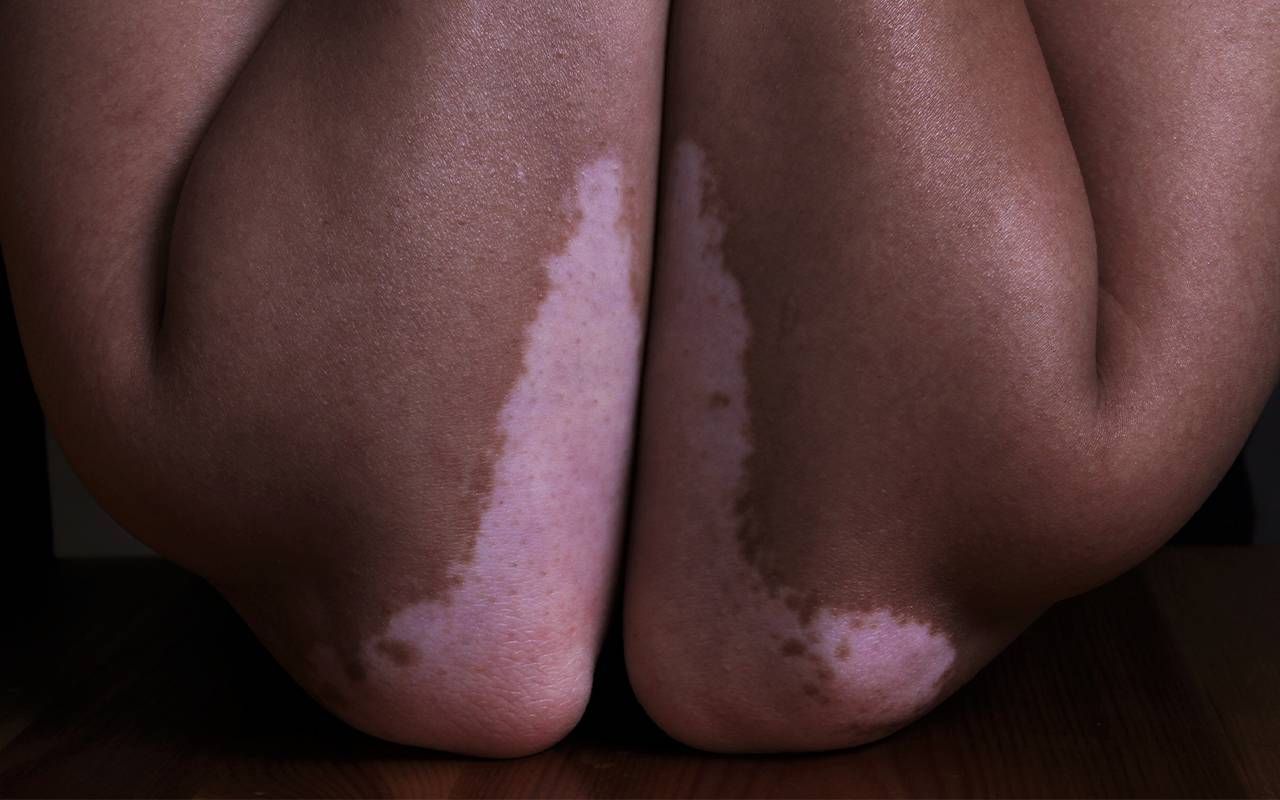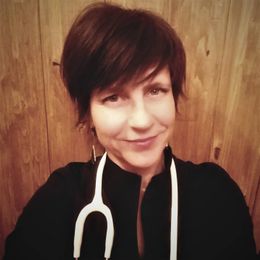More Than Skin Deep: Embracing Vitiligo
Valarie Molyneaux is on a mission to help everyone like herself, living with vitiligo, to feel whole and free
There's a joy and peace in Valarie Molyneaux's eyes — a hard-fought change from the fear they showed in 2002 when the doctor said, "I can't help you. There's no cure." Many of the 1.5 million other Americans diagnosed with vitiligo heard the exact words. Like Molyneaux, they felt disfigured, humiliated and alone in a disapproving world where people stare and point.

For years Molyneaux hid the change in her face with thick makeup, terrified of anyone seeing her without it until she finally considered ending it all. Years ago, driving past Jamaica Pond, part of a chain of Boston parks along the Muddy River, she battled a fierce urge to drive her car into the water and let it sink to the bottom.
Vitiligo (pronounced vit-ill-EYE-go) is a lifelong medical condition that lightens skin in uneven and unpredictable patches.
Thoughts of her husband, Roy, who she says "loves me immensely" — vitiligo and all — and her "two gorgeous little boys at home" kept her eyes on the road, tears streaming down her face.
Vitiligo isn't new. Records exist of ancient civilizations writing about skin turning white, often confusing it with leprosy. However, despite a long history and estimates of 100 million people worldwide with the condition, there is still no cure or precisely known cause.
Vitiligo (pronounced vit-ill-EYE-go) is a lifelong medical condition that lightens skin in uneven and unpredictable patches. Currently considered an autoimmune disorder, often with a genetic component, scientists think emotional stress, environmental factors, certain toxins or chemicals, injured digestion or other events may trigger vitiligo.
These catalysts prompt the immune system to attack and destroy melanocytes – pigment-producing cells that color skin. Unfortunately, many people still think it's a "Black condition," says Molyneaux, the CEO and founder of VITFriends, a vitiligo support community she founded in 2009.
However, like other research, a study published in JAMA Dermatology in 2022 found it affects more white Americans than Black. The truth is vitiligo doesn't discriminate. It affects light skin and dark skin, young and old skin, male and female.
The actual number of people with vitiligo is hard to count since as many as 40% more may be undiagnosed. Most cases start in people under age 40, with 50% starting in people younger than 20. As Americans live longer, however, incidents of vitiligo are increasing in adults over age 40 – known as late-onset vitiligo.
The Emotional Impact of Vitiligo
Oddly enough, both Molyneaux and her husband, Roy, developed vitiligo after 40 — Valarie in 2002 and Roy in 2005. Their Boston support group has six members over 80, all of whom have late-onset vitiligo. Molyneaux is certain the stress and loss of loved ones during the Covid-19 pandemic sparked new vitiligo cases in older adults.
Vitiligo is neither life-threatening nor contagious, but it's emotionally wracking at any age.
Vitiligo is neither life-threatening nor contagious, but it's emotionally wracking at any age. When it hits older adults already facing the challenges of aging, it's alarming. And when it touches your grandchild, it's heartbreaking. Fortunately, treatments are expanding to restore pigmentation, like the topical drug, Opzelura, the first and only FDA-approved vitiligo product.
But the story doesn't end with treatment. Many, like Molyneaux, don't improve with various therapies. And even when the treatments help, living with vitiligo can be devastating and humiliating, bringing daily stares and comments from well-meaning people and menacing bullies alike.
Molyneaux's first white patch appeared on her thumb – about the size of a fingernail. Today, she is nearly ivory white with a few dark patches, a transformation requiring support and faith to embrace fully.
"My great-grandfather was an Irishman. I was a Black woman. Today, I'm a little more like my great -grandfather," she tells me, one hand gesturing around her face. "My milk chocolate is gone. Yeah, but I embrace this. I love me. I love all of this."
Listening to Molyneaux's story, it's clear "all of this" means something more than skin deep. Along with feeling disfigured and losing her cherished dark skin, Molyneaux found a mission and passion for supporting others with vitiligo — especially young ones — and she loves the work.
When the doctor declared no cure, Molyneaux needed help and "someone to talk to," but no support group existed. So Molyneaux turned to her belief in a God who cares.
Finding Support
"I gathered a group of women in the back of the church in January 2009," she recalls. "I said, 'We're going to sing, and we're going to pray.' That's all I said. Everybody loves singing and praying. They didn't have a clue that I was trying to heal me. In January 2009, we started that group. And we have never stopped."

Today, people from all over the United States, Jamaica, Trinidad and the Virgin Islands attend virtually on Zoom every Monday night. By July of that year, Molyneaux was ready for more, spurred by growing confidence as the Monday gatherings healed her inner turmoil.
Sitting down at her computer, she posted on Facebook, "If you have vitiligo, would you meet me at the Dorchester Bowling Alley?" Families and individuals from New York City, Connecticut, New Hampshire and Boston gathered at that bowling alley, all desperate like Molyneaux for a supportive community. That night, VITFriends was born.
Today the organization boasts sixteen support groups, two for kids (ages 4-12) and teens (ages 13-20), an award-winning podcast with nearly 11,000 global listeners, a vitiligo book reading program for schools and libraries, and an upcoming documentary called More Than Our Skin.
Taking Action Against Vitiligo
VITFriends is changing the face of vitiligo. Still, Molyneaux sees even bigger things in the future with an eye on Washington.
In 1975 and 1977, Representative Parren J. Mitchell of Maryland presented the National Vitiligo Control Act, which according to Molyneaux, still sits in the House waiting for approval. "This condition is not respected," she laments, asserting it's underserved and underfunded.
VITFriends wants the government to require insurance companies to change their language about vitiligo. Designated as a mere "cosmetic condition," most insurance plans won't cover treatment costs.
"You are not disfigured. You are beautiful."
Opzelura is the first treatment labeled for vitiligo and has an impressive success rate. However, a small 2-ounce tube costs most patients $2000. For Molyneaux, passing legislation is one of her most demanding tasks.
"We will go down fighting," Molyneaux says. "I'm asking God for strength to enable me to see that something is established, not just, not for me – I'm getting older – but for the next generation, for these babies."
In the meantime, Molyneaux is out to "shore up and encourage" anyone facing vitiligo by welcoming them into the VITFriends family. "You are not disfigured. You are beautiful," she declares, encouraging people with vitiligo to change their language.
Molyneaux encourages older adults noticing spots for the first time to visit the VITFriends website to learn more and find support. VITFriends — whose motto is "Belong. Empower. Live" — is partly supported by The Vitiligo Research Foundation, another comprehensive source, especially for treatment research.
VITFriends provides life-changing support through their global youth programs — Vitiligo Pen Pal Patch and Purple Patch Teens for grandparents and parents of a child with vitiligo. A retired kindergarten teacher, Molyneaux also works tirelessly to stock school libraries with children's books about vitiligo through her Read Across America program. She welcomes all to join her cause.
More than anything, whether there's a physical cure or not, Molyneaux is on a mission to help every person with vitiligo feel whole and free. So instead of the phrase ringing in your ear, "There's no cure," remember, "You're not disfigured. You are beautiful."


